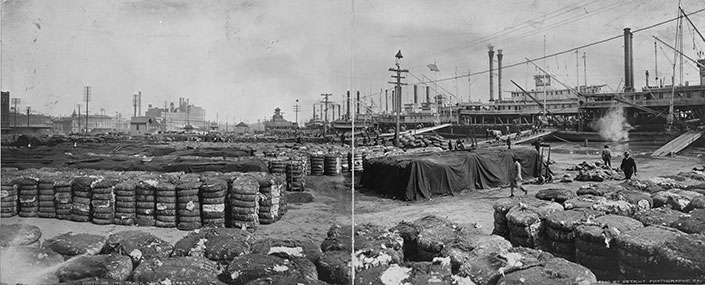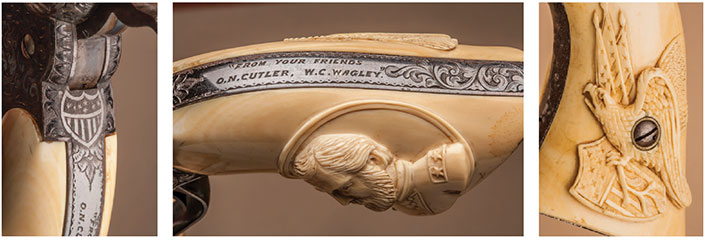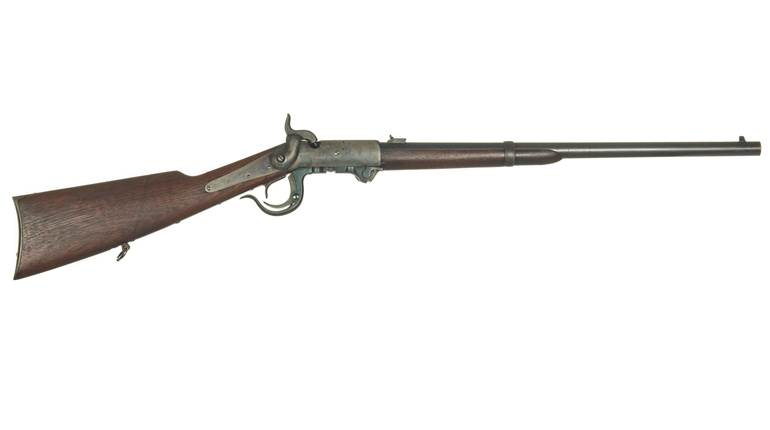
When Cotton Was King
The year was 1863—a pivotal time in the Civil War—and America was a deeply divided country of 20 Union and 13 Confederate states, anything but united, with secession and slavery politically and socially paralyzing both sides. The protracted conflict and unrelentingly bloody battles had already resulted in hundreds of thousands of casualties, and many citizens were convinced the country might never get back to its pre-war constitutional elements—a land of life, liberty and the pursuit of happiness.
The location was war-ravaged Louisiana, which was in a complete state of chaos and anarchy outside the capital of New Orleans. Throughout the 19th century, the cotton trade was one of the world’s largest industries, and the majority of raw cotton was harvested by slave labor in the deep South. Prior to the war, most of this cotton was exported to Britain, where its dominant textile industry consumed millions of pounds annually. A month after the Civil War erupted at Fort Sumter on April 12, 1861, Britain declared its neutrality and the Union Navy quickly blockaded the Atlantic seaports and, shortly thereafter, the Gulf of Mexico. Confederate commerce with England was drastically reduced, creating a major loss in revenue for the desperately needed war chest. Despite large pre-war reserves, England ran out of cotton in late 1862, as did the North. As a result, the price of cotton, which had been approximately 10 cents a pound in 1860, skyrocketed to $1.89 a pound in the North during 1863—if it could be successfully shipped to the East Coast for the multitude of Union Civil War uses.
This high-priced “white gold” quickly resulted in a large variety of drastically war-altered entrepreneurial activities in the cotton-producing southern states, but especially in Louisiana. While New Orleans fell under Union occupation in May 1862, the rest of the state was a mixed bag of isolated Union outposts and scattered rebel strongholds where lawlessness was the rule. At the time, it was still possible to buy cotton for as little as 20 cents a pound in the war-torn state, even though the Confederacy had ordered the destruction of all cotton (and whiskey) that might fall into Union hands. Confederates destroyed 15 times more cotton than the Union confiscated during the entire Civil War.
Multiple obstacles occurred for cotton speculators, however. With the Confederacy controlling the states surrounding Louisiana, shipping by rail wasn’t possible, nor were sea shipments up the Atlantic corridor. The only remaining solution was to try and ship this bulky cargo by boat up the Confederate-controlled Mississippi River. President Lincoln had declared Vicksburg, Miss., the “key” to liberating the “Father of Waters,” and it wasn’t until Vicksburg (defeated by Grant’s troops) and Port Hudson, La., fell to the Union in July 1863 that shipping cotton became easier and more predictable. Even with those victories though, on any given night on the Mississippi, nothing was guaranteed on either side for safe passage until late 1863.

“Up-The-River” Gambling
To begin with, purchasing raw cotton was not easy, as it had to be paid for in federal cash (typically “greenbacks,” not backed by gold or silver), and the unreliable sources included rogue elements of the Confederate government, rebels needing federal cash and loyalist citizens wanting their income back. Once purchased, the cotton needed to be packed, loaded and transported to the Mississippi River to be shipped upstream to Union-controlled Memphis, a distance of approximately 400 miles. While the potential monetary rewards were unequalled at the time, the risks were also exceedingly high, with graft and corruption becoming central elements in most negotiations. Yet, if everything went according to plan, it was possible to make up to $175,000 in one shipment. One observer noted that the “mania for sudden fortunes in cotton” meant that “Every [Union] colonel, captain or quartermaster is in secret partnership with some operator in cotton.” The lure of sudden cotton wealth would entice white Northern civilians and Union soldiers to travel south both during and after the war.
The best way to ensure a successful cotton shipment to Memphis was to get cooperation and assistance from Union forces. This meant forming an alliance and writing contracts with high-ranking Union officers stationed in Louisiana. General James B. McPherson was such a person—a first-in-his-class West Point graduate who was commander of the Union-occupied New Orleans district. One of his most important cotton sources was William C. Wagley, who served as a second lieutenant in the 3rd Dragoons during the Mexican-American War. Major William H. Polk was in Wagley’s regiment, and received a pair of silver-mounted Colt revolvers from his brother, President James K. Polk, delivered circa 1847. Wagley was a plantation owner in the area, but also plundered the nearby abandoned plantations for their unpicked cotton crops. He was responsible for establishing contracts approved by McPherson to deliver unpicked and abandoned cotton, and was also mentioned in Abraham Lincoln’s letters. This cotton was processed, when delivered on government transports, at the contractor’s expense. The sizeable profits were divided equally between the Union and contractual parties.
Otis Nelson Cutler was a veteran of the Mexican-American War and had been a captain, but like Wagley, did not serve during the Civil War. He was originally from Maine and had already established himself as a swashbuckling adventurer who led a company of 40 men from Massachusetts to California in 1858 to capitalize on the new Gold Rush. A few years later, he helped build the Hannibal and St. Joseph Railroad in Missouri, establishing himself as assistant superintendent. When the war broke out, Cutler was appointed as special treasury agent by Treasury Secretary William P. Fessenden and stationed in New Orleans. After the war, he became a banker in New York and, later, a member of the New York Stock Exchange.
 The Perils Of The “Cotton Baggers”
The Perils Of The “Cotton Baggers”
In his position, and with considerable financial backing available, Cutler typically took over Wagley’s interest in these cotton contracts. One of the early documented shipments was especially doomed for failure. This 1863 contract specified Wagley to deliver 268 bales of cotton, weighing 113,900 lbs., to Lake Providence for future shipment up the Mississippi to Memphis. The court-documented price paid was 25 cents per pound. Wagley then assigned his interest to O.N. Cutler due to his financial connections. While the load of cotton was being stored at Lake Providence awaiting shipment to Memphis, Gen. Ulysses S. Grant, who had the final say on what the Union shipped on the river, required transportation for his army across the Mississippi River below Vicksburg. To accomplish this, steamboats were needed to run through the enemy-held river blockade. Grant and his quartermaster seized Cutler’s cotton and positioned it on the steamer Tigress to protect the boat’s machinery from lethal enemy cannon fire from Vicksburg. The Tigress tried to run the blockade, but her precious load of cotton was lost on the voyage. In 1868, the government finally reimbursed Cutler $50,000 for this lost shipment.
After Confederate control of the Mississippi ended during mid-1863, cotton shipments to the East Coast became both more frequent and reliable thanks to the Union’s “delivery protection service,” but only if the right people were involved. A 50/50 profit-sharing arrangement between the Union and cotton suppliers was the norm for these contracts. This lucrative arrangement generated massive amounts of revenue for both the Union and Cutler/Wagley, and no doubt, Generals McPherson and Grant.
The Remington Set Is Ordered
Indebted to both generals, what better way of expressing gratitude to both McPherson and Grant than to present each of them with a set of highly embellished cased revolvers? A well-documented, exquisite pair of ornately engraved Colt Model 1861 Navy revolvers (Serial Nos. 11756 and 11757) was presented to Gen. McPherson first, with the inscription on both backstraps “From his Friends, O.N. Cutler and W.C. Wagley.” These famous Colts were formerly part of both the William M. Locke and Dr. Joseph Murphy collections. Interestingly, until the sale of the Murphy collection in 2009, no one had ever established the historical Civil War connection between O.N. Cutler and W.C. Wagley. When both men decided to reward Gen. Grant for similar Civil War services, it was only fitting they chose the latest and most up-to-date revolver—Remington’s New Model Army that went into production in June 1863, chambered for .44 cal. More than 100,000 revolvers were contracted to the Union, and manufacture was completed by war’s end.

During this turbulent period of American arms manufacture, perhaps the best and most expeditious way of getting a cased presentation set of Remington revolvers custom made was to place a special order with the New York City-based firm of Schuyler, Hartley and Graham, America’s largest gun retailer and wholesaler in 1860. The firm was responsible for maintaining a robust inventory of currently manufactured firearms, which was very unusual at the time. After Cutler and Wagley placed their order, the well-known merchant would have started by purchasing the commercial revolvers from Remington, which offered special-order arms removed from the normal production line. Serial numbers were within their own separate series, and research indicates that fewer than 100 of these revolvers were made during the Civil War. A well-documented, almost identical, embellished set of New Model Armys was thought to have been presented to the Czar of Russia after Stephen Lisovski of the Russian Imperial Atlantic Fleet sailed into New York City’s harbor in September 1863. Most locals thought the fleet’s arrival indicated Russia’s show of support for the Union.
The next step would have been to have the arms properly embellished “in the white,” and the pattern and execution of the engraving style indicate this most important creative process was done by the firm of L.D. Nimschke, also from New York City. Once finished, the guns would have been polished, blued and, finally, fitted to a deluxe presentation case with proper accessories by an established case maker. Easily, this set’s most stunning features are the elaborately carved ivory stocks featuring high relief portrait busts of Grant and American eagle motifs, also attributed to Nimschke. The overall cost of the extravagant gift was no more than $400, with the revolvers’ original value at about $12 each. The set could have either been picked up or delivered to a specific location as per Cutler and Wagley’s request.

From New York City To San Diego
Unfortunately, it is not known exactly when or where this set of Remington revolvers was presented to Gen. U.S. Grant, but considering the economic windfall both parties were enjoying, it was most likely a low-key event wherever Grant was stationed. Neither Grant nor his wife Julia lead lavish lifestyles, so the set was probably stored out of sight with little fanfare at their post-war house located at 3 East 66th St. in New York City.
Grant’s children were Frederick (oldest), Ulysses, Jr., Jesse and Nellie. Jesse Grant (the general’s youngest son) and his family moved to San Diego in the late 1880s, and Ulysses, Jr., followed with his family in 1893. Along with the family’s other possessions, the Remington set apparently headed west with one of them. Thriving financially, Ulysses, Jr., built the U.S. Grant Hotel in San Diego during 1910 as a tribute to his father, and Jesse helped him with the management. Both brothers were very active politically and well-known within San Diego society for their philanthropy and real estate ventures. Additionally, Jesse was a candidate for the Democratic presidential nomination in 1908.
As the set’s condition indicates, these lavish revolvers were not exposed to sunlight, which would have degraded the finish and adversely affected the lining within the case. The Remingtons must have remained in a secure place with the family in virtual obscurity until Jesse passed away in 1934. Jesse Grant’s second wife, Lillian Wilkins, has been credited with helping to save many of the Ulysses S. Grant artifacts. Grant V, the grandson of Jesse, became custodian of the many items and artifacts, including the late president’s letters and will, and most likely, the Remington set. The legacy of the magnificent Remington presentation revolvers belonging to various Grant descendants remained intact.

The Set Is Finally Sold
When the Jesse Grant home needed repair work, a handyman for the family received this set of Remingtons as payment for his services. The current owner’s father, who was a gun fancier and friend of the handyman, found out about the presentation set during the 1950s. While the handyman stubbornly refused to sell the guns for 10 years, a sale was finally transacted in the amount of $1,500, as documented in a copy of the sales receipt. Incredibly, just like the Grant family, the purchaser never showed anyone the set, and it remained unknown to historians and collectors. The Remingtons were passed down to his son in 2013.
Decades earlier, his father had previously purchased items from noted antique arms specialist Greg Martin through Shotgun News and kept all his receipts. Going through his father’s paperwork, the current owner came across Martin’s phone number and decided to call him to see if he was still in business. Picking up the phone, the veteran dealer heard “I have in my possession a cased pair of Remington revolvers that were presented to a general and was wondering if you might be interested in them.” Taken by surprise, Martin didn’t ask who the general was at first, but let the current owner discuss the set more in detail. After the conversation finished, the two arranged to meet, view the set together and discuss a possible sales arrangement. Upon opening the promising-looking, deluxe-rosewood presentation case, the experienced dealer instantly realized who the general was, as he described a carved bust of Grant was “staring him in the face.” After more than six months of further negotiations, the owner agreed to place the Grant revolvers on consignment because his son was going to college, and he felt the time had come to part with his heirloom.
One more very important obstacle quickly became a major consideration for the set to make its first debut in more than 125 years. All parties had to assure the California Fish & Wildlife Dept. that the ivory stocks (also numbered to the revolvers) were antiques and at least 100 years old. To overcome this potential legal hurdle, an experienced and qualified ivory expert was hired to examine the stocks, and obtain a certificate from the state certifying the type of ivory, its origin and age. After all necessary licenses were in place, Gen. Grant’s Remingtons were displayed at the Las Vegas Antique Arms Show in January 2018. Without a doubt, these cased Remingtons constitute the most elaborate and historically significant set of currently known revolvers manufactured during the Civil War.

S.P. Fjestad is the author and publisher of the Blue Book of Gun Values, with over 1.8 million copies in print worldwide.
Acknowledgements: The author would like to express his thanks to the following: Greg Martin, specialist for fine Antique Arms and Armor; Conor Fitzgerald, extensive and thorough background historical research; Charles F. Priore, Jr., additional research; Roy Marcot, noted Remington author and historian; and Cassandra J. Faulkner, manuscript supervisor and research coordinator.






































